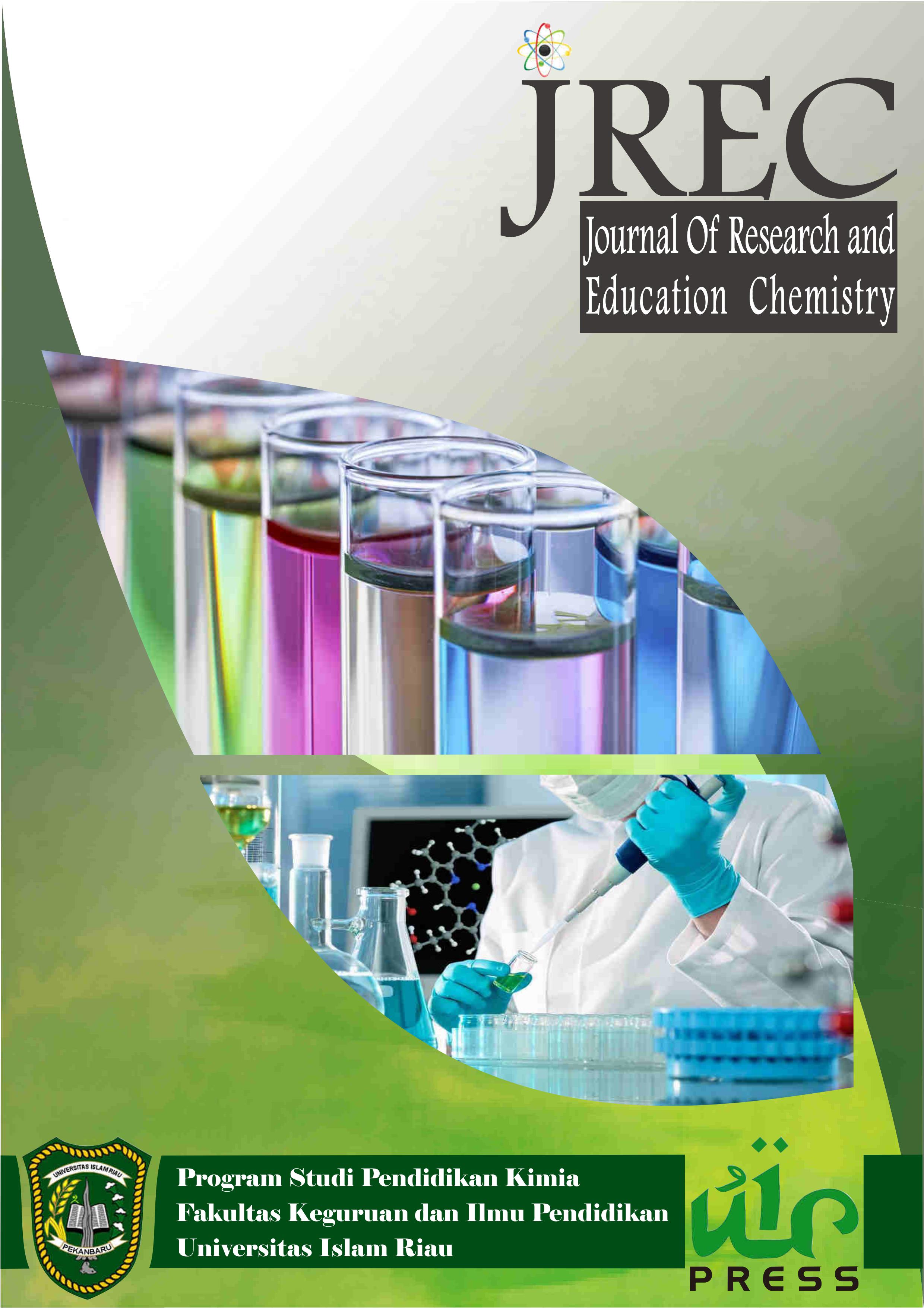PERBANDINGAN SENYAWA SIANIDA PADA DAUN SINGKONG DENGAN PERENDAMAN NaHCO3 DAN Ca(OH)2
DOI:
https://doi.org/10.25299/jrec.2022.vol4(1).9332Keywords:
Cassava, Cyanide Acid, NaHCO3 and Ca(OH)2Abstract
Cassava contains the 80-90% carbohydrates, while Cassava leaves contain proteins, minerals, vitamins, and toxins that called Glucocide Cyanogenic. Glucose Cyanogenic can be hydrolyzed into Cyanide Acid which can bond with fe 2+ or fe 3+ in blood so that be able to degrade oxygen levels in the body cells. The purpose of this study is to know the effects of submersion NaHCO3 solution and Ca(OH)2 solution with time variations of submersion to the levels of cyanide in the cassava leaves. The pressence of Cyanide in the cassava leaves uses UV vis Spectrophotometer. The data was statistically analyzed by using a two-way anova test. According to the research, the highest levels of Cyanide found in NaHCO3 solution with 41,2656 ppm, with a reduction levels of Cyanide by 22.05% and The Ca(OH)2 with 53,9218 ppm with a reduction of Cyanide levels by 34.77% in 1 hour soaking. A statistical value of 0.106 and 0.116 (p>0.05) indicates that there is no differences of submersion of NaHCO3 solution and Ca(OH)2 solution with the time variatons that already done.
Downloads
References
Cahyawati , N., Zahran , I., Jufri, I., & Noviana. (2017). Keracunan Sianida. Jurnal Lingkungan & Pembangunan , 1(1), 80-87.
Cardoso, A., Mirione, E., Ernesto, M., Massaza, f., Cliff, J., Haque, M., et al. (2005). Processing of Cassava Roots to Remove Cyanogens. Journal of Food Composition and Analysis, 18, 451-460.
Daniel, A., Ebisike, Adeeyinwo, Adetunji, Olusunle, & Adewoye. (2013). Production of Sodium Cyanide from Cassava Wastes. Internasional Journal of Science and Technology, 2(10), 707-709.
Day, R., & Underwood, A. (2002). Analisis Kimia Kuantitatif (Edisi Keenam ed.). Jakarta: Erlangga.
Dinas Pertanian. (2019, Januari 03). Budidaya Tanaman Singkong. Retrieved Januari 03, 2019, from Website Resmi Pemerintah Kabupaten Buleleng: https://www.bulelengkab.go.id/detail/artikel/budidaya-tanaman-singkong-41
Gandjar, G., & Rohman Abdul. (2018). Spektroskopi Molekuler Untuk Analisis Farmasi. In Tanti, & Nanik, Spektroskopi Molekuler Untuk Analisis Farmasi (p. 50). Yogyakarta: Gadjah Mada University Press.
Hartati, I., & Kurniasari, L. (2008). Inaktivasi Enzimatis Pada Produksi Linamarin Dari Daun Singkong Sebagai Senyawa Anti Neoplastik. Jurnal Ilmiah Momentum, 4(2), 1-6.
Hasrianti, Nururrahmah, & Nurasia. (2016). Pemanfaatan Ekstrak Bawang Merah Dan Asam Asetat Sebagai Pengawet Alami Bakso. Jurnal Dinamika, 9-30.
Indrawati , R., & Ratnawati , J. (2017). Pengaruh Perendaman Larutan Kapur Sirih Terhadap Kadar Asam Sianida Pada Biji Karet. JURNAL LABORATORIUM KHATULISTIWA, 1(1), 58-56.
Kurnia , N., & Marwatoen , F. (2013). Penentuan Kadar Sianida Daun Singkong Dengan Variasi. Jurnal Ilmiah Pendidikan Kimia “Hydrogen”, 1(2338-6480), 2.
Kurniati, E., & Kusdiyantini, E. (2015). Optimasi Linamarase pada Umbi Singkong (Manihot esculenta Crantz) dan Umbi. Jurnal Biologi, 4(4), 14-19.
Kusumawardhani, N., & Sulistyati, h. (2015). Penentuan Panjang Gelombang Maksimum Dan Ph Optimum Dalam Pembuatan Tes Kit Sianida Berdasarkan Pembentukan Hidrindantin. Kimia Student Journal, 711-717.
Masturoh, I., & T Anggita, N. (2018). Metodolgi Penelitian Kesehatan. In Bahan Ajar Rekam Medis dan Informasi Kesehatan (RMK) (p. 307). Kementrian Kesehatan Republik Indonesia: Pusat Pendidikan Sumber Daya Manusia Kesehatan .
Montagnac, J., Davis, C., & Tanumihardjo, S. (2009). Processing Techniques to Reduce Toxicity an Antinutrients of Cassava for Use as a Staple Food. Comprehensive Reviews in Food Science and Food Safety, 8, 17-27.
Mulja, M., & Suharman. (1995). Analisis Instrumental (Cetakan Pertama ed.). Surabaya: Airlangga University Press.
Prijana, & Rohman, S. (2016). Studi Eksperimen Mengenai Metode Baca Good Reading. Lentera Pustaka, 2(2), 71-81.
Purwati, Y., Thuraidah, A., & Rakhmina, D. (2016). Kadar Sianida Singkong Rebus dan Singkong Goreng. Medical Laboratory Technology Journal, Vol 2(2):46-50.
Putri, E. (2017). Penentuan Konsentrasi Senyawa Berwarna KMnO4 Dengan Metoda Spektroskopi UV Visible. NATURAL SCIENCE JOURNAL, 3(1), 391-398.
Rahayu , S., Utami, I., & Fajar, I. (2009, Desember 03). Penetapan Kadar Tablet Ranitidin Menggunakan Metode Spektrofotometri Uv-Vis Dengan Pelarut Metanol. PHARMACY, 06(03).
Sari , K., R Jenny , G., & Syari, P. (2019). Perbedaan Kadar Asam Sianida Pada Ubi Kayu Sebelum Dan Sesudah Direndam Dengan Larutan Nahco3 Konsentrasi 5, 10 Dan 15% Selama 12 Jam. Jurnal Laboratorium Khatulistiwa, 2(2), 57-59.
Sari , N., & Astili, R. (2018). Kandungan Asam Sianida Dendeng dari Limbah Kulit Singkong . Jurnal Dunia Gizi , Vol 1(1): 20-29.
Sembiring, T., Dayana , I., & Rianna, M. (2019). Alat Penguji Material. Medan: Guepedia Publisher.
Toro, N., Roosmarianto, & Rahayu , M. (2014). Pengaruh Lama Perendaman Koro Bengu (Mucuna Pruriens) Dalam Air Kapur (Ca(Oh)2) Terhadap Kadar Asam Sianida (Hcn). Jurnal Teknologi Laboratorium, 1.
Triana, L., & Kamilla, l. (2018). Analisis Kadar Asam Sianida Pada Ubi Kayu yang Direndam Dalam LArutan NaHCO3 20 % Dengan Variasi Waktu. Jurnal Laboratorium Khatulistiwa, Vol 2(2):130-136.
Triyati , E. (1985). Spektrofotometer Ultra-Violet Dan Sinar Tampak. Oseana, 10(1), 39-47.
Triyati, E. (1985). Spektrofotometer Ultra-Violet Dan Sinar Tampak Serta Aplikasinya Dalam Oseanologi. Oseana, X(1), 39-47.
Tsani , A., Sulistiyani, & Budiyono. (2018). Analisis Risiko Pajanan Sianida Pada Masyarakat Desa Ngemplak Kidul Kecamatan Margoyoso Kabupaten Pati. Jurnal Kesehatan Masyarakat (e-Journal), 6(4), 159-165.
Wahyuni, F., & Sumarsono, H. (2017). Pengaruh Linamarin Terhadap Penampilan Reproduksi Induk Mencit (Mus Musculus L.). Jurnal Ipteks Terapan, 11(i4), 288-299.
Wididastuti, V., Ernawati, E., Fatmadewi, V., Anindyajati, S., & Faradina, N. (2017). Analysis of Cyanide Content on Yams Using. Indonesian Journal of Chemistry and Environment, 7-14.
Wrono , D., & Syamsudin. (2013). Unjuk Kerja Spektrofotometer Untuk Analisa Zat Aktif Ketoprofen. KONVERSI, 2.
Yanlinastuti, & Fatimah , S. (2016). Pengaruh Konsentrasi Pelarut Untuk Menentukan Kadar Zirkonium Dalam Paduan U-Zr Dengan Menggunakan Metode Spektrofotometri Uv-Vis. 22-33.
Zulfah , L., Sulistyarti, H., & Atikah. (2015). Pengaruh Waktu Pembentukan Dan Kestabilan Hidrindantin Serta Konsentrasi Ninhidrin Pada Pembuatan Tes Kit Sianida. Kimia Student Journal, 704-710.







